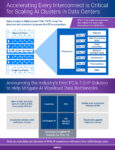Coverage improvement effectiveness through randomized testing declines as total coverage improves. Attacking stubborn holes in coverage could be augmented through learned novel test guidance to random test selection. Paul Cunningham (GM, Verification at Cadence), Raúl Camposano (Silicon Catalyst, entrepreneur, former… Read More
Electronic Design Automation
Podcast EP230: An Overview of the Siemens EDA Calibre 3D Thermal Announcement at DAC with Dr. John Ferguson
Dan is joined by Dr. John Ferguson, senior director of marketing for the Calibre product line at Siemens EDA. John has worked extensively in physical design verification. Current activities include efforts to extend physical verification and PDK enablement for 3DIC design and silicon photonics.
Dan explores the Siemens EDA… Read More
Synopsys’ Strategic Advancement with PCIe 7.0: Early Access and Complete Solution for AI and Data Center Infrastructure
In the rapidly evolving world of high-performance computing (HPC) and artificial intelligence (AI), technological advancements must keep pace with increasing demands for speed, efficiency, and security. Synopsys recently announced the industry’s first complete PCIe 7.0 IP solution. This groundbreaking initiative addresses… Read More
System VIPs are to PSS as Apps are to Formal
In the formal world the core technology is extremely powerful, and specialist users need full access to tackle difficult problems. But for many applications, teams prefer canned solutions built on the core technology yet scalable to non-experts. A similar dynamic appears to be playing out between System VIPs and PSS. PSS, the… Read More
Breker Verification Systems at the 2024 Design Automation Conference
Breker Verification Systems will demonstrate its new RISC-V CoreAssurance™ and SoCReady™ SystemVIP™ along with its Trek Test Suite Synthesis portfolio during the 61st Design Automation Conference (DAC) in Booth #2447. DAC will be held from Monday, June 24, through Wednesday, June 26, from 10 a.m. until 6 p.m. at Moscone West… Read More
Pragmatic at the 2024 Design Automation Conference
Pragmatic is pioneering a fundamental shift in semiconductor technology, delivering lower-cost, lower-carbon intelligence to power the Internet of Everything. Its FlexIC – flexible integrated circuit – technology delivers connect, sense and compute capabilities at a fraction of the cost and carbon footprint of silicon… Read More
Empyrean at the 2024 Design Automation Conference
AMIQ EDA at the 2024 Design Automation Conference
AMIQ EDA is a pioneer in integrated development environments (IDEs) for hardware design and verification and a provider of platform-independent software tools for efficient code development and analysis. We’ve been attending DAC for many years and are pleased to do so again in 2024. We exhibit at this show for several reasons.… Read More
Sigasi at the 2024 Design Automation Conference
Sigasi® will demonstrate its Sigasi Visual HDL™ (SVH™) portfolio during DAC, showing how it supports the shift-left methodology for chip design, catching specification errors early in the design cycle and fixing the inefficient HDL-based design flow.
The traditional HDL workflow cannot accommodate the massive amounts of… Read More
Innova at the 2024 Design Automation Conference
Design projects are becoming more and more complex. The success of a design project is tightly linked to the best preparation. Having an accurate and precise prediction of either project design resources or design parameters, with a plan to react in an appropriate way is crucial and cost saving.
A typical example is the availability… Read More





Quantum Computing Technologies and Challenges